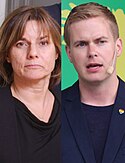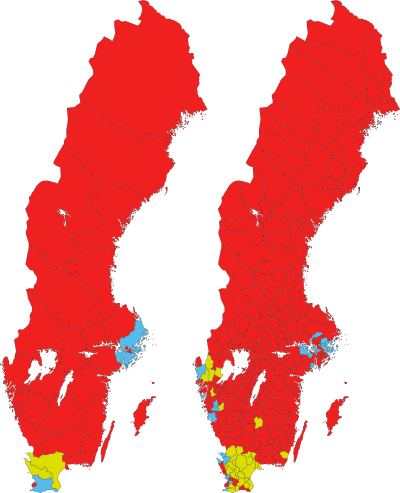
Back الانتخابات العامة السويدية 2018 Arabic Eleiciones xenerales de Suecia de 2018 AST Eleccions generals sueques de 2018 Catalan Parlamentní volby ve Švédsku 2018 Czech Wahl zum Schwedischen Reichstag 2018 German Σουηδικές γενικές εκλογές 2018 Greek Elecciones generales de Suecia de 2018 Spanish انتخابات سراسری سوئد (۲۰۱۸) Persian Ruotsin valtiopäivävaalit 2018 Finnish Élections législatives suédoises de 2018 French
| |||||||||||||||||||||||||||||||||||||||||||||||||||||||||||||||||||||||||||||||||||||||||||||||||||||||||||||||||||||||
All 349 seats in the Riksdag 175 seats needed for a majority | |||||||||||||||||||||||||||||||||||||||||||||||||||||||||||||||||||||||||||||||||||||||||||||||||||||||||||||||||||||||
|---|---|---|---|---|---|---|---|---|---|---|---|---|---|---|---|---|---|---|---|---|---|---|---|---|---|---|---|---|---|---|---|---|---|---|---|---|---|---|---|---|---|---|---|---|---|---|---|---|---|---|---|---|---|---|---|---|---|---|---|---|---|---|---|---|---|---|---|---|---|---|---|---|---|---|---|---|---|---|---|---|---|---|---|---|---|---|---|---|---|---|---|---|---|---|---|---|---|---|---|---|---|---|---|---|---|---|---|---|---|---|---|---|---|---|---|---|---|---|---|
| Opinion polls | |||||||||||||||||||||||||||||||||||||||||||||||||||||||||||||||||||||||||||||||||||||||||||||||||||||||||||||||||||||||
| Turnout | 87.1% ( | ||||||||||||||||||||||||||||||||||||||||||||||||||||||||||||||||||||||||||||||||||||||||||||||||||||||||||||||||||||||
| |||||||||||||||||||||||||||||||||||||||||||||||||||||||||||||||||||||||||||||||||||||||||||||||||||||||||||||||||||||||
General elections were held in Sweden on 9 September 2018 to elect the 349 members of the Riksdag. Regional and municipal elections were also held on the same day. The incumbent minority government, consisting of the Social Democrats and the Greens and supported by the Left Party, won 144 seats, one seat more than the four-party Alliance coalition, with the Sweden Democrats winning the remaining 62 seats. The Social Democrats' vote share fell to 28.3 percent, its lowest level of support since 1911.
The main opposition, the Moderates, lost even more support. The Sweden Democrats made gains, though less than anticipated.[1][2][3][4][5][6] Regardless, the party became the largest in two constituencies in southern region Scania and topped the polls in 21 out of 33 Scanian municipalities and in 31 out of 290 municipalities overall.[7] The voter turnout of 87.18%[7] was the highest in 33 years and 1.38 percentage points higher than the 2014 elections. A record 26 out of 29 constituencies returned a hung parliament.[7] 46% of seats were won by women (161 out of 349).[8] The number has since increased to 47.2% (165 out of 349).[9]
Following the elections, Prime Minister Stefan Löfven lost a vote of no-confidence on 25 September, forcing a parliamentary vote on a new government. In the meantime, his government remained in power as a caretaker government.[10] Speaker Andreas Norlén nominated Moderate leader Ulf Kristersson to form a government on 9 November. However, Kristersson lost a vote to confirm him in office by a margin of 154–195. He was supported by his own Moderate Party, the Christian Democrats and the Sweden Democrats, despite having ruled out this scenario before the election, but the Liberals and the Centre Party, the other parties in the centre-right Alliance, were not willing to form a government reliant on the Sweden Democrats.[11][12] On 15 November, Norlén invited Centre Party leader Annie Lööf to try to form a government, but she was unable to do so. Norlén then nominated Löfven, but following unsuccessful negotiations with the Centre Party and the Liberals he lost a confirmation vote 116–200 on 14 December.[13]
Hours after the failed vote to confirm Löfven, Norlén announced that he would be meeting with representatives of the Election Authority regarding a potential extraordinary election. The Speaker also stated that he would be engaging in talks with the parties during the weekend and that he would present the next phase of the government formation process by the following week.[14] Löfven was finally re-elected with a 115–153 result as prime minister on 18 January 2019 after the Social Democrats struck an agreement with the Greens, the Liberals, and the Centre Party;[15] and after the Left Party reluctantly agreed to abstain from voting against Löfven.[15] Due to Sweden's principle of negative parliamentarism this result was enough, as less than the majority of the parliament voted against him, while the supporting parties abstained. The result saw a breakup of the Alliance with the remaining right-wing parties aligning closer with the Sweden Democrats in parliament.
With the government being down to 116 seats (59 short of a majority), this rendered it the government with the lowest electoral support to begin a term during universal suffrage in Sweden and forced to approve several liberal policy platforms the government had campaigned against.[16] With the right-wing opposition having 154 seats, to the coalition and confidence and supply agreements' 167 and the Left Party's 28, it still rendered a hung parliament even after the government formation, which exposed the government to high-profile losses in parliament.[17] With the Liberals leaving the confidence and supply after a no-confidence vote in 2021, the de facto parliamentary blocs ended being 175 to 174 with the de facto majority for the red-greens being 0.1%. The metropolitan versus small town divide got stronger. With the 2021 constellations, the election saw Södermanland and Västmanland retroactively flip to the right for the first time during universal suffrage dating back a century, while also Blekinge went blue for the first time in the unicameral era.[7] Meanwhile, the six largest municipalities had leftist majorities.[7]
- ^ "Sweden faces hung parliament as far-right makes big gains". Irish Times.
- ^ (now), Kate Lyons; (earlier), Patrick Greenfield; Greenfield, Patrick (9 September 2018). "Swedish election: deadlock for main parties as far right makes gains – as it happened". The Guardian.
- ^ Carl Bildt. "Opinion - Sweden's election represents the new normal of European politics". Washington Post.
- ^ Chatterjee, Saikat (10 September 2018). "FOREX-Scandinavian currencies lead rebound vs struggling dollar". CNBC. Archived from the original on 25 December 2018. Retrieved 10 September 2018.
- ^ "Sweden faces government deadlock as far-right gains". The Times of India.
- ^ Schultheis, Emily (10 September 2018). "Sweden's Far Right Has Won the War of Ideas". Foreign Policy. Retrieved 11 September 2018.
- ^ a b c d e "Röster - Val 2018". data.val.se. Archived from the original on 17 December 2018. Retrieved 18 January 2019.
- ^ "Ålder och kön - Val 2018". data.val.se. Retrieved 6 May 2020.
- ^ "Percentage of women in national parliaments as of March 2020". New Parline: the IPU’s Open Data Platform (beta). Retrieved 6 May 2020.
- ^ Cite error: The named reference
:0was invoked but never defined (see the help page). - ^ Alexandra Carlsson Tenitskaja; Mia Holmgren (13 November 2018). "SD röstar ja till Kristersson som statsminister". DN.SE (in Swedish). Retrieved 13 November 2018.
- ^ Alexandra Carlsson Tenitskaja (14 November 2018). "Nu avgörs Kristerssons statsministeröde". DN.SE (in Swedish). Retrieved 14 November 2018.
- ^ "Riksdagen röstar nej till Stefan Löfven (S) som statsminister". Dagens Nyheter (in Swedish). 14 December 2018. Retrieved 14 December 2018.
- ^ "Talmannen Andreas Norlén förbereder ett eventuellt extraval". Dagens Nyheter (in Swedish). 14 December 2018. Retrieved 14 December 2018.
- ^ a b "Stefan Löfven voted back in as Swedish prime minister". www.thelocal.se. 18 January 2019. Retrieved 18 January 2019.
- ^ Nyheter, S. V. T.; Wedin, Helena (21 March 2019). "Uppgörelsen mellan S, MP, L och C - punkt för punkt". SVT Nyheter (in Swedish). SVT. Retrieved 28 January 2020.
- ^ "Oppositionen är överens – vill ge 7,5 miljarder till välfärden" (in Swedish). Expressen. 22 January 2020. Retrieved 28 January 2020.
© MMXXIII Rich X Search. We shall prevail. All rights reserved. Rich X Search









